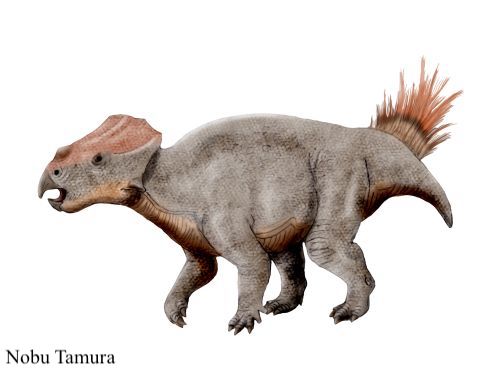Welcome to Ajkaceratops

Name Definition
Horned face from Ajka (Ajka is pronounced oi-ka)
Name Given By
Attila Ősi, Richard J. Butler, and David B. Weishampel in 2010
Location
Csehbánya Formation in Veszprém County, Hungary
Classification
Dinosauria, Ornithischia, Ceratopsia, Coronosauria, Bagaceratopsidae
Size
estimated to be about 0.3 meters tall, about 1 meter long, estimated to be about 20 kg
Temporal Range
Santonian stage of the late Cretaceous, around 85 million years ago
Ecological niche
small herbivore
Species/Sub Species
A. kozmai
Diet
most likely a herbivore and fed on low vegetation
Introduction
Ajkaceratops is a genus of ceratopsian dinosaurs that lived in Hungary during the late Cretaceous. Ajkaceratops means “Horned face from Ajka”, Ajka being a city in Hungary that was near where the fossils of Ajkaceratops were found. The specific name, kozmai, honors Károly Kozma. Ajkaceratops, despite not being known from many fossils, is one of the most important finds of the 21st century. Until then, ceratopsians were only known from Asia and North America, even the most primitive like Psittacosaurus, however, the discovery of the Hungarian Ajkaceratops has changed our perception of ceratopsian distribution. Ajkaceratops was seen to be most closely similar to the bagaceratopsids, a family of primitive ceratopsians, and are mainly known from Mongolia. One of the main reasons people have started to believe about Ajkaceratops’ odd location for a ceratopsian is that its ancestors may have spread from Asia to North America and as well as Europe. Similar to its bagaceratopsid relatives, Ajkaceratops would have been relatively small compared to the other late Cretaceous ceratopsians like Chasmosaurus and Styracosaurus (also lacking the ornate horns on the frill), and would have used its beak to crop the lush low vegetation that grew there since back in the late Cretaceous. The Csehbánya Formation was believed to have been a floodplain back in the Cretaceous. Because of this, occasional silt from the floods would have seeped into the soil, and silty soil is usually more fertile than others, supporting better and richer plants. Scientists also speculate Ajkaceratops would have lived in a drier upstream habitat, but maybe it was just washed downstream due to a flood. Known only from the Csehbánya Formation, Ajkaceratops lived with other paleofauna like fish, amphibians, squamates (snakes, lizards, and amphisbaenians), crocodyliformes, turtles, pterosaurs including the azhdarchid Bakonydraco, the nodosaurs Struthiosaurus and Hungarosaurus, the paravian theropod Pneumatoraptor, the rhabdodontid Mochlodon, and some other indeterminate theropods and sauropods have also been discovered from the formation. The formation also includes the fossils of an indeterminate enantiornithine (birds that had the common attributes of theropod dinosaurs like teeth and claws but apart from that were just primitive birds) bird, and the avisaurid enantiornithine Bauxitornis